Jackie: At last — we made it to spring and all the usual accoutrements have shown up — lilacs, violets, the smell of apple blossoms, and thoughts of sprouting seeds and growing vegetables. How could we not look at picture books about gardens and farming this month?
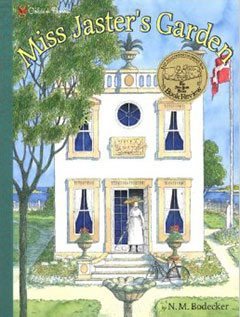 I have to confess, Phyllis, I did not know of Miss Jaster’s Garden, written and illustrated by N. M. Bodecker and published in 1972. I’m so glad to meet Miss Jaster and Hedgie the hedgehog whom she treats with a bowl of milk each night. “But hedgehogs being the shape they are, and Miss Jaster being a little nearsighted, as often as not she put the saucer where the hedgehog’s head wasn’t. And Hedgie — so as not to cause distress — “politely dipped his tail in the milk and pretended to drink.”
I have to confess, Phyllis, I did not know of Miss Jaster’s Garden, written and illustrated by N. M. Bodecker and published in 1972. I’m so glad to meet Miss Jaster and Hedgie the hedgehog whom she treats with a bowl of milk each night. “But hedgehogs being the shape they are, and Miss Jaster being a little nearsighted, as often as not she put the saucer where the hedgehog’s head wasn’t. And Hedgie — so as not to cause distress — “politely dipped his tail in the milk and pretended to drink.”
That’s not the only problem caused by Miss Jaster’s poor vision. When she is scattering flower seeds in her garden she does not see Hedgie and plants seeds on him too. “…after a while he began feeling restless.” Hedgie is sprouting. Hedgie blooms! And feels like dancing. “Tomorrow I’ll be as quiet as an earthworm,” thought Hedgie, “but not today. Today is the greatest day of my life. There’ll never be another like it!” When Miss Jaster sees flowers dancing in the yard, she yells, “STOP THIEF!” and poor Hedgie, frightened and chagrined, runs off. Eventually the Chief Constable, with a capable bit of sleuthing, finds Hedgie and brings him back — “a weary, worried, bedraggled little animal, down on his luck.” Miss Jaster feels bad at having given the hedgehog (“flowerhog”) such a scare. And they take breakfast together every morning — “And there was nothing but peace and sunshine and a touch of Sweet William.”
I love the tone of this book — Hedgie is up for the adventure of being a walking flower garden. The constable is thoughtful, “Did you by chance, happen to notice how many legs these flowers had when they made their getaway? In round numbers?” In round numbers! And I love the characters — the hedgehog who’s so thoughtful he pretends to drink with his tail so as not to upset Miss Jaster. And kind Miss Jaster who doesn’t mind sharing her garden with a hedgehog and is actually pleased when she realized that she also shared flower seeds with him.
This story has a lot of text. But the humor is so wonderful and the characters just the right degree of eccentric, I think it would be enjoyed by the five to ninety crowd. What do you think?
Phyllis: I didn’t know this book, either, but I also love it. The double-page spread map at the beginning of the book is a little story all in itself, as good maps often are. From Hedgie’s corner to the birdbath (“For ancient inscription, see page 17”) to Miss J’s wicker chair and Sunrise Hill (“Elevation 9’”) Bodecker has created a whole world in art as well as text.
As someone who has become nearer and nearer sighted my whole life, I completely understand how Miss Jaster might make such a mistake. And who wouldn’t want a walking flower garden? Who wouldn’t want to be a flower garden? I love how the ending brings mutual satisfaction to Miss Jaster and to Hedgie, who have always been solicitous of each other — each morning they share “a leisurely breakfast … and a walk along the beach, followed by a small but persistent butterfly.”
Certainly the text is much longer than many more recent picture books, but what wonderful details! When Miss Jaster goes out to plant she does so in “a purple morning-dress and sturdy shoes” with a “large straw hat, trimmed with cornflowers on her head,” pulling “a small four-wheeled wagon full of garden tools and flower seeds.” Like a garden in full bloom, the story is lush with language.
I love, too, how Hedgie, as he discovers he’s sprouting, wonders which he will be: “’Flower bed or vegetable garden? Vegetable garden or flower bed?’” until one day, “’I’m in bloom!’ cried Hedgie.”
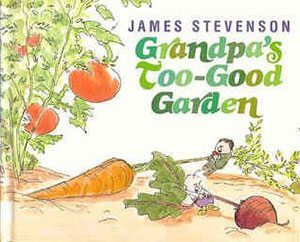 Jackie: I call James Stevenson the writer with the humor cure. He makes me laugh. And Grandpa’s Too Good Garden is one of his curing-est. Mary Ann and Louie are disappointed with their gardening. Louis says, “We dig and rake and plant and water and weed — and nothing ever comes up. Our garden is no good.” Grandpa remains calm and tells them he once had a garden that was “a little too good.” There are some wonderful cartoon‑y frames of Grandpa and Wainey in the garden (both as kids with little mustaches) but the story really begins when Father throws his Miracle Grow hair tonic out the window. It spills into the garden and gets rained in. Before Wainey even wakes up a vine snatches him up and almost out the window. The garden was taller than the house. Giant caterpillars came to eat the giant plants. The plants continued to grow and Grandpa got “snagged on a weather vane above our roof.” Grandpa is in trouble…only to be rescued by Wainey on a giant butterfly. This happy ending is accompanied by Wainey showing up to offer Grandpa and the kids some ice cream. I love the exaggeration, the total silliness of it.
Jackie: I call James Stevenson the writer with the humor cure. He makes me laugh. And Grandpa’s Too Good Garden is one of his curing-est. Mary Ann and Louie are disappointed with their gardening. Louis says, “We dig and rake and plant and water and weed — and nothing ever comes up. Our garden is no good.” Grandpa remains calm and tells them he once had a garden that was “a little too good.” There are some wonderful cartoon‑y frames of Grandpa and Wainey in the garden (both as kids with little mustaches) but the story really begins when Father throws his Miracle Grow hair tonic out the window. It spills into the garden and gets rained in. Before Wainey even wakes up a vine snatches him up and almost out the window. The garden was taller than the house. Giant caterpillars came to eat the giant plants. The plants continued to grow and Grandpa got “snagged on a weather vane above our roof.” Grandpa is in trouble…only to be rescued by Wainey on a giant butterfly. This happy ending is accompanied by Wainey showing up to offer Grandpa and the kids some ice cream. I love the exaggeration, the total silliness of it.
Phyllis: Gardeners need patience, but not all of us wait quietly. When the seeds don’t grow quickly enough, Wainey and Grandpa encourage them. “’Hello, beans? Tomatoes? Are you down there? Give us a sign!’ ‘Hello, carrumps?” The fortuitous hair tonic reminds me of old radio science fiction shows. “You threw the growth formula out back?” the scientist asks his assistant just before the now-giant earthworms come banging on the door. There’s a satisfying circularity to Grandpa’s garden story when one of the giant butterflies that metamorphed from the giant caterpillars rescues both brothers. Wonderful wackiness!
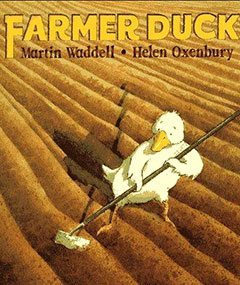 Jackie: Farmer Duck by Martin Waddell (illustrated by Helen Oxenbury) is set on a farm and Farmer Duck does farm work so we are including it. It’s all about friends. And friends are important to gardeners. Who else would take our extra zucchini? or help us pull weeds? or share plants with us?
Jackie: Farmer Duck by Martin Waddell (illustrated by Helen Oxenbury) is set on a farm and Farmer Duck does farm work so we are including it. It’s all about friends. And friends are important to gardeners. Who else would take our extra zucchini? or help us pull weeds? or share plants with us?
This is such an exuberant telling. Was there ever a lazier farmer than the human farmer who stays in bed all day, yelling to the duck, “How goes the work?” Farmer Duck always responds the same way, “Quack.” This goes on day after day. While the lazy farmer eats bon bons, the duck saws wood, spades the garden, washes dishes, irons clothes. The other animals can’t stand to see their friend work so hard. One night they meet in the barn and make a plan. “’Moo!’ said the cow./’Baa!’ said the sheep./ ‘Cluck!’ said the hens. And that was the plan.”
When they carry out their plan the lazy farmer runs away and never returns. “…mooing and baaing and clucking and quacking, they all set to work on their farm.” We just can’t help but think hay will be sweeter, corn will be taller, and there may be dancing in the barn.
Phyllis: I adore this book, text and art. The duck looks wearier and wearier, and who wouldn’t want to be comforted by such caring hens and the other animals as well? And I love how the animals that the duck tended to at the beginning of the story, including carrying a sheep from the hill, all pitch in to help at the end as “mooing and baaing and clucking and quacking, they all set to work on their farm.” Animals, unite! The fruits of the labor belong to the laborers!
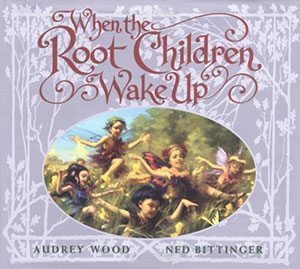 Jackie: I would be remiss not to mention your namesake book, Phyllis—When The Root Children Wake Up, retold by Audrey Wood and illustrated by Ned Bittinger. It’s a story of seasons. A robin comes to the window of Mother’s Earth’s underground “home” and calls, “Root Children! Root Children …Wake up! It’s time for the masquerade.” The children awaken the bugs and paint them and head out for the masquerade. But it’s not too long before “Cousin Summer slips his knapsack on his back and quickly strides over the hills and far away.” Time for Uncle Fall. And soon it will be time for another winter’s nap.
Jackie: I would be remiss not to mention your namesake book, Phyllis—When The Root Children Wake Up, retold by Audrey Wood and illustrated by Ned Bittinger. It’s a story of seasons. A robin comes to the window of Mother’s Earth’s underground “home” and calls, “Root Children! Root Children …Wake up! It’s time for the masquerade.” The children awaken the bugs and paint them and head out for the masquerade. But it’s not too long before “Cousin Summer slips his knapsack on his back and quickly strides over the hills and far away.” Time for Uncle Fall. And soon it will be time for another winter’s nap.
There’s a lot about this story that I like — the circle of seasons, painting the bugs. I’m a little put off by the very realistic drawings of children as the “Root Children.” I’m not sure why. Maybe because they seem too real to be sleeping underground all winter. Makes me feel claustrophobic. Maybe I’m just grumpy. I’d love to know what others think.
 Phyllis: It’s true that what caught my eye about When the Root Children Wake Up was my name in the title, but I also love the story and art in the version I have, a reprint of the 1906 Sybelle Olffers book first published in Germany and republished in English in 1988 by Green Tiger Press. The charmingly old-fashioned original illustrations remind me of books I loved as a child and include a joyous spread of the root children emerging above ground carrying flowers and grasses “into the lovely world.” Interesting how art can change the perception of a story!
Phyllis: It’s true that what caught my eye about When the Root Children Wake Up was my name in the title, but I also love the story and art in the version I have, a reprint of the 1906 Sybelle Olffers book first published in Germany and republished in English in 1988 by Green Tiger Press. The charmingly old-fashioned original illustrations remind me of books I loved as a child and include a joyous spread of the root children emerging above ground carrying flowers and grasses “into the lovely world.” Interesting how art can change the perception of a story!
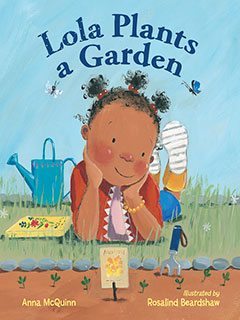 A garden book for the very young is Lola Plants a Garden by Anna McQuinn, illustrated by Rosaline Beardshaw. The straightforward story tells how Lola loves the poem “Mary Mary Quite Contrary” and wants to plant a garden of her own. She and Mommy read books about gardens, make a list of Lola’s favorite flowers, buy seeds, and plant them. While she waits for them to grow, Lola makes their own book about flowers, strings beads and shells and bells, and makes a little Mary Mary doll. Lola’s patience and work are rewarded as the flowers grow big and “Open toward the sun.” Daddy helps her hang her bells, her friends come to her garden to eat Mommy’s peas and strawberries, and Lola makes up a story for them about Mary Mary. The book concludes, “What kind of garden will Lola plant next?” Simply told and satisfying, the book makes me want to run out and buy more packets of flower seeds, then invite friends to come visit in the garden and encourage them to grow.
A garden book for the very young is Lola Plants a Garden by Anna McQuinn, illustrated by Rosaline Beardshaw. The straightforward story tells how Lola loves the poem “Mary Mary Quite Contrary” and wants to plant a garden of her own. She and Mommy read books about gardens, make a list of Lola’s favorite flowers, buy seeds, and plant them. While she waits for them to grow, Lola makes their own book about flowers, strings beads and shells and bells, and makes a little Mary Mary doll. Lola’s patience and work are rewarded as the flowers grow big and “Open toward the sun.” Daddy helps her hang her bells, her friends come to her garden to eat Mommy’s peas and strawberries, and Lola makes up a story for them about Mary Mary. The book concludes, “What kind of garden will Lola plant next?” Simply told and satisfying, the book makes me want to run out and buy more packets of flower seeds, then invite friends to come visit in the garden and encourage them to grow.
Jackie: Friends and gardens and the cycle of seasons. We are all rooted on this earth. And that’s good to remember. Let’s go plant some beans.


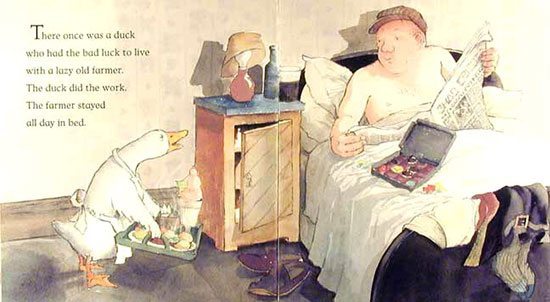
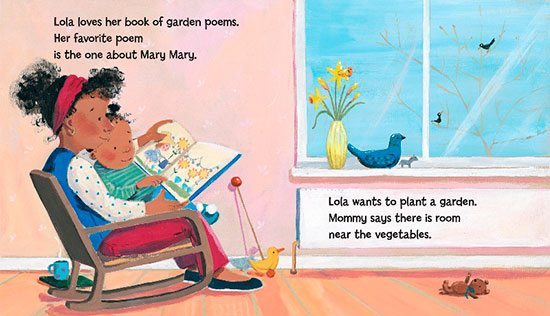
Wonderful! I just returned from my favorite nursery with flowers so this column is perfect timing. My grandkids love Farmer Duck so much that I keep it in my car so they can read it again and again. To the garden now!
Farmer Duck is so much fun! Quack. And I think kids will laugh at Miss Jaster’s Garden. In the Martin garden is a new bean tower. And maybe even magic beans. Definitely much excitement!